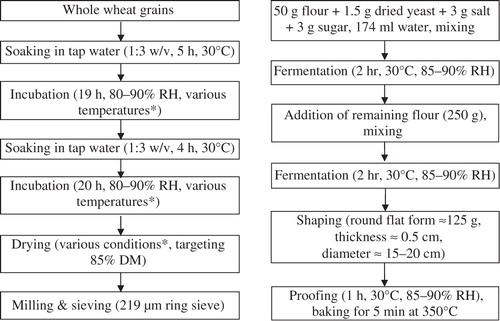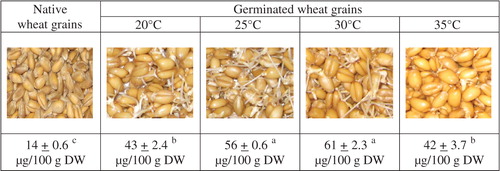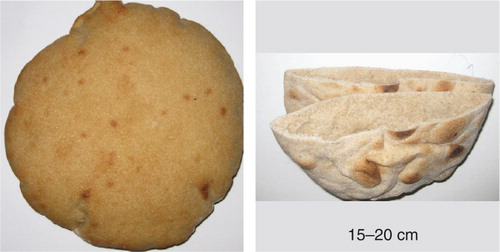Introduction
Egypt has a high incidence of neural tube defects related to folate deficiency. One major food source for folate is pita (baladi) bread, which is consumed daily. Bioprocessing (e.g. germination) has been reported to increase the folate content in cereals. The aim was to produce pita bread with increased folate content using germinated wheat flour (GWF).
Methods
Prior to milling the effects of germination and drying conditions on folate content in wheat grains were studied. Pita bread was baked from wheat flour substituted with different levels of GWF. The folate content in dough and bread and rheological properties of dough were determined.
Results
Germination of wheat grains resulted in, depending on temperature, 3- to 4-fold higher folate content with a maximum of 61 µg/100 g DM (dry matter). The folate content in both flour and bread increased 1.5 to 4-fold depending on the level of flour replacement with GWF. Pita bread baked with 50% sieved GWF was acceptable with respect to colour and layer separation, and had a folate content of 50 µg/100 g DM compared with 30 µg/100 g DM in conventional pita bread (0% GWF).
Conclusion
Using 50% GWF, pita bread with increased folate content, acceptable for the Egyptian consumer, was produced. Consumption of this bread would increase the average daily folate intake by 75 µg.
Egypt has an estimated incidence of neural tube defects of 4.5/1,000 pregnancies Citation1 Citation2 indicating that folate deficiencies exist in several population groups Citation3. One of the important folate sources in Egypt is wheat flour with a per capita consumption as high as 363 g/day, providing about 66% energy Citation4. Wheat flour is almost completely consumed in the form of pita bread, which in Egypt is referred to as baladi bread. It is circular, flat bread with almost no crumbs forming a pocket from two layers () and is produced from high extraction rate wheat flour. There is no agreement on characteristics to judge the quality of pita bread Citation5 but layer separation, crust, shape, and colour are the parameters for subjective evaluation. No representative folate intake data are available for Egypt, but it was estimated that cereal foods could contribute with ca 60% to the daily folate intake Citation6.
Recently in 2010, Egypt introduced mandatory folic acid and iron fortification of the flour used for the production of subsidised pita bread (Citation7; personal communication with Prof Azza Gohar, National Nutrition Institute, Cairo, Egypt) to reduce incidence of both neural tube defect pregnancies and anaemia. However, there is still a debate regarding the ambiguous role of synthetic folic acid in promotion of, for example, colorectal cancer Citation8 and other potential adverse or positive health effects Citation9–Citation12. Therefore, careful monitoring and adjustment of the fortification level is necessary after beginning the fortification programme and complementive approaches to enhance folate intake in the Egyptian population are demanded.
Different methods of bioprocessing (e.g. fermentation and germination) have been shown to increase the content of folate and other micronutrients in cereal-grain and other foods Citation13–Citation17, and several of these methods are commonly used during household and industrial production of traditional and contemporary Egyptian foods.
An aim of the current study was to increase the folate content in pita bread using a traditional Egyptian household procedure for the preparation and as candidate functional ingredient germinated wheat flour.
Material and methods
Food samples
Wheat grains (triticum aestivum) and wheat flour (extraction rate 82%) were supplied from Lantmännen, Järna, Sweden. Grains were harvested in the year 2008 and derived from an unknown mix of varieties commonly grown in Sweden. Dried yeast (Kronjäst, Jästbolaget, Sollentuna, Sweden) was purchased in a food store in Uppsala.
Experimental
Germination and drying experiments and subsequent milling for the preparation of wheat flour for pita bread baking were carried out as depicted in . Germination was carried out in a leavening cupboard (Elektro Helios, Stockholm, Sweden) during 48 hr at 20, 25, 30, and 35°C. The following drying conditions for wheat germ (germinated at 30°C) were tested using a drying oven (Heraeus, D-63450, Hannover, Germany): 35°C for 6 hr; 50°C for 4 hr; 70°C for 2 hr; and 90°C for 1 hr, aiming for a final dry matter (DM) of 85%.
Fig. 2. Preparation of germinated wheat flour (left) and pita bread baking (right). *Germination was carried out at 20, 25, 30, and 35°C. Drying conditions were 35°C for 6 hr, 50°C for 4 hr, 70°C for 2 hr, and 90°C for 1 hr. RH = relative humidity, DM = dry matter.

Pita bread was baked using a sponge dough method (; 300 g flour, 1.5 g dried yeast, 3 g NaCl, 3 g sugar, 174 ml water), using flour (extraction rate 82%) substituted with 0, 25, 50, or 100% sieved (219 µm) germinated (30°C for 48 hr, ) wheat flour.
Folate content in dough and bread samples was quantified using HPLC Citation6. DM in cereal, dough, and bread samples was determined according to AOAC Citation18. Rheological properties of the dough were determined by farinograph (Brabender OHG, Duisburg, Germany) according to AACC Citation19.
Data are expressed as mean and standard error of mean (SEM) from duplicate trials and duplicate analysis. The sum of quantified folate forms (tetrahydrofolate, 5-methyl-tetrahydrofolate, and 10-formyl-folic acid) was after correction for molecular weights expressed as folic acid in µg/100 g DM Citation20. Treatments and their effect on folate content were compared using the general linear model. Effects of the different conditions within each treatment were analysed using Tukey's pairwise comparison (SAS, version 9.1, SAS Institute Inc., Cary, NC, USA); differences were considered significant at p>0.05.
Results and discussion
Germination of wheat grains resulted, in accordance to findings by others Citation16 Citation17, in a 3- to 4-fold higher folate content as compared to the initial 14 µg/100 g (). Maximum folate content was found after germination at 25 and 30°C (). The folate content of unsieved and sieved germinated wheat flour (GWF) (after germination at 30°C) was 72 + 3 µg/100 g and 56 + 3 µg/100 g DM. Drying of germinated wheat grains did not significantly (p = 0.61) affect the folate content as compared to fresh germinated grains, resulting in a folate content of 56–72 µg/100 g DM.
Fig. 3. Folate content (µg/100 g DM±SEM) in native and germinated wheat grains at different temperatures. Folate values (means from duplicate trials and duplicate analyses) are the sum of quantified folate forms (tetrahydrofolate, 5-methyl-tetrahydrofolate, and 10-formyl-folic acid) expressed as folic acid after correction for molecular weights. Different superscripts represent significant differences (p<0.05).

The addition of increasing amounts of sieved germinated wheat flour resulted in enhanced folate content in dough, but rheological properties were affected adversely (). Baking of pita bread after addition of various amounts of sieved germinated wheat flour resulted in a net increase of folate content in both flour and bread (). Pita bread baked with 50% sieved GWF was acceptable with respect to taste, colour, and layer separation (data not shown; 20), and had a folate content of 50 µg/100 g DM compared with 30 µg/100 g DM in conventional bread (0% GWF). Fermentation of dough increased the folate content (); similar observations were reported for other types of bread Citation13 Citation14. Subsequent baking of the pita bread did not affect the folate content ().
Fig. 4. Folate content (µg/100 g DM) and dough stability time (min) in dough samples prepared after substitution with sieved germinated wheat flour (GWF). Folate values (means from duplicate trials and duplicate analyses) are the sum of quantified folate forms (tetrahydrofolate, 5-methyl-tetrahydrofolate, and 10-formyl-folic acid) expressed as folic acid after correction for molecular weights. Dough stability data are derived from duplicate trials.

Fig. 5. Folate content (µg/100 g DM, ±SEM) in flour (left, green bars) and bread (right, maroon bars) after substitution with sieved GWF. Folate values (mean from duplicate trials and duplicate analyses) are the sum of quantified folate forms (tetrahydrofolate, 5-methyl-tetrahydrofolate, and 10-formyl-folic acid) expressed as folic acid after correction for molecular weights. Bars with different letters within the same group are significantly different (p<0.05).

Conclusions
Egyptian pita bread with enhanced folate content of 50 µg/100 g (compared to 30 µg/100 g using native wheat flour) could be produced by adding 50% sieved GWF. Consumption of this bread would increase the average daily folate intake by approximately 75 µg.
Conflict of interest and funding
A PhD grant (MH) from the Egyptian Ministry of Higher Education is gratefully acknowledged. We would like to thank Lantmännen R&D, Järna, Sweden, for supplying the wheat grains and flour and Lantmännen Mills AB, Uppsala, Sweden, for the milling. Folate standards were a kind gift from Merck Eprova AGF, Schaffhausen, Switzerland.
Fig. 6. Net increase of folate content (µg/100 g DM, ±SEM) in pita bread with 50% sieved GWF during baking. Folate values (mean from duplicate trials and duplicate analyses) are the sum of quantified folate forms (tetrahydrofolate, 5-methyl-tetrahydrofolate, and 10-formyl-folic acid) expressed as folic acid after correction for molecular weights. Bars with different letters are significantly different (p<0.05).

Acknowledgements
The authors of this extended abstract acknowledge the reproduction of essential information from ‘Increasing the folate content in Egyptian baladi bread using germinated wheat flour’ by Hefni and Witthöft. Thanks are due to LWT – Food Science and Technology for giving us permission to reproduce parts of this article.
References
- Flour Fortification Initiative (FF). FFI country information: Egypt. Overview of progress toward fortification; http://www.sph.emory.edu/wheatflour/Egypt.php; 2009 [cited 24 August 2010].
- Temtamy SA, Abdel Maguid N, Mazen I, Ismail SR, Kassem NS, Bassiouni R. A genetic epidemiological study of malformations at birth in Egypt. 1998; 4: 252-9
- Hussein L, Hermann-Kunz E, Dortschy E, Kohlmeier L, Kuhn G. Food consumption patterns and nutrient intakes among selected Egyptian population groups deferring in their socioeducation status. 1995; 10: 75-113
- Food and Agricultural Organization FAO. Food balance sheet. Egypt – 2005; http://faostat.fao.org/site/368/default.aspx#ancor; 2005 [cited 4 November 2007].
- Morad MM, Doherty CA, Rooney LW. Effect of sorghum variety on baking properties of US conventional bread, Egyptian pita ‘balady’ bread and cookies. 1984; 49: 1070-4. 10.3402/fnr.v56i0.5566
- Hefni M, Öhrvik V, Tabekha M, Witthöft C. Folate content in foods commonly consumed in Egypt. 2010; 121: 540-5. 10.3402/fnr.v56i0.5566
- Global Alliance for Improved Nutrition GAIN. WFP, MOSS and GAIN celebrate start of flour fortification in Egypt to reduce widespread anemia by 28%; http://www.gainhealth.org/press-releases/wfp-moss-and-gain-celebrate-start-flour-fortification-egypt-reduce-widespread-anemia-; 2009 [cited 27 November 2009].
- Mason JB, Dickstein A, Jacques PF, Haggarty P, Selhub J, Dallal G et al. A temporal association between folic acid fortification and an increase in colorectal cancer rates may be illuminating important biological principles: a hypothesis. 2007; 16: 1325-9. 10.3402/fnr.v56i0.5566
- Boushey CJ, Beresford SA, Omenn GS, Motulsky AG. A quantitative assessment of plasma homocysteine as a risk factor for vascular disease. 1995; 274: 1049-57. 10.3402/fnr.v56i0.5566
- Seshadri S, Beiser A, Selhub J, Jacques PF, Rosenberg IH, D'Agostino RB et al. Plasma homocysteine as a risk factor for dementia and Alzheimer's disease. 2002; 346: 476-83. 10.3402/fnr.v56i0.5566
- Wald DS, Law M, Morris JK. Homocysteine and cardiovascular disease: evidence on causality from a meta-analysis. 2002; 325: 1202-6. 10.3402/fnr.v56i0.5566
- Smith AD, Kim Y-I, Refsum H. Is folic acid good for everyone?. 2008; 87: 517-33
- Osseyi ES, Wehling RL, Albrecht JA. HPLC determination of stability and distribution of added folic acid and some endogenous folates during breadmaking. 2001; 78: 375-8. 10.3402/fnr.v56i0.5566
- Kariluoto S, Vahteristo L, Salovaara H, Katina K, Liukkonen KH, Piironen V. Effect of baking method and fermentation on folate content of rye and wheat breads. 2004; 81: 134-9. 10.3402/fnr.v56i0.5566
- Jägerstad M, Piironen V, Walker C, Ros G, Carnovale E, Holasova M et al. Increasing natural food folates through bioprocessing and biotechnology. 2005; 16: 298-306. 10.3402/fnr.v56i0.5566
- Kariluoto S, Liukkonen K, Myllymäki O, Vahteristo L, Kaukovirta-Norja A, Piironen V. Effect of germination and thermal treatments on folates in rye. 2006; 54: 9522-8. 10.3402/fnr.v56i0.5566
- Koehler P, Hartmann G, Wieser H, Rychlik M. Changes of folates, dietary fiber, and proteins in wheat as affected by germination. 2007; 55: 4678-83. 10.3402/fnr.v56i0.5566
- AOAC. Official methods of analysis. 17th ed. Arlington, VA: Association of Official Analytical Chemists; 2000.
- AACC. Approved methods of American association of cereal chemists. 10th ed. St Paul, MN: American Association of Cereal Chemists; 2000.
- Hefni M, Witthöft CM. Increasing the folate content in Egyptian baladi bread using germinated wheat flour. 2011; 44: 706-12. 10.3402/fnr.v56i0.5566
